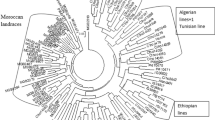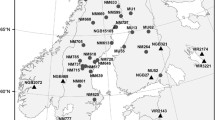Abstract
We analyzed the genetic diversity in 88 genotypes from 20 populations of wild barley (Hordeum spontaneum C. Koch) from Israel, Turkey and Iran, by randomly amplified polymorphic DNA (RAPD). Twenty two of the 33 primers used yielded scorable products with 1–11 polymorphic bands. No duplicate patterns were found except for four haplotypes.When the total genetic diversity was estimated, 75% of the variation detected was partitioned within the 88 genotypes and 25% among the populations. When variation between countries was assessed, no substantial differences were found, because most of the variation detected (97%) was partioned within the 20 populations and the remainder among countries. The results of this limited survey indicate that the extensive genetic diversity is present in natural stands of wild barley throughout the Fertile Crescent.
Similar content being viewed by others
References
Armstrong, J.S., A.J. Gibbs, R. Peakall, & G. Weiller, 1994. The RAPDistance Package, obtainable via Anonymous FTP or WWW. ftp://life.anu.edu.au/pub/RAPDistance; or http://life.anu.edu.au/molecular/software/rapd.html
Dawson, I.K., K.J. Chalmers, R. Waugh & W. Powell, 1993. Detection and analysis of genetic variation in Hordeum spontaneum populations from Israel using RAPD markers. Mol. Ecol. 2: 151-159.
Demeke, T., R.P. Adams & R. Chibbar, 1992. Potential taxonomic use of random amplified polymorphic DNA (RAPD): a case study in Brassica. Theor. Appl. Genet. 84: 990-994.
Dice, L.R., 1945. Measures of the amount of ecologic association between species. Ecology 26: 297-302.
Excoffier, L., 1995. AMOVA 1.55 obtainable via Anonymous FTP or WWW. ftp:/acasun1.unige.ch/pub/com/win/amova; or http://acasun1.unige.ch/LGB/Software/Windoze/amova
Excoffier, L., P. Smouse & J. Quattro, 1992. Analysis of molecular variance inferred from metric distances among DNA haplotypes: application to human mitochondrial DNA restriction data. Genetics 131: 479-491.
Felsenstein, J., 1993. PHYLIP (Phylogeny Inference Package) Version 3.5c. Distributed by the author. Department of Genetics, University of Washington, Seattle.
González, J.M. & E. Ferrer, 1993. Random amplified polymorphic DNA analysis in Hordeum species. Genome 36: 1029-1031.
Gower, J.C., 1966. Some distance properties of latent root and vector methods used in multivariate analysis. Biometrika 53: 325-338.
Harlan, J.R. & D. Zohary, 1966. Distribution of wild wheat and barley. Science 153: 1074-1080.
Hoefer. 1993. Instructions; TKO 102 standards kit; 24278/Rev C/7-9-93. Hoefer Scientific Instruments, San Francisco. 9 p.
Huff, D.R., R. Peakall & P.E. Smouse, 1993. RAPD variation within and among natural populations of outcrossing buffalograss (Buchloë dactyloides (Nutt.) Engelm.). Theor. Appl. Genet. 87: 201-208.
Jaccard, P., 1901. Etude comparative de la distribution florale dans une portion des Alpes et des Jura. Bull. Soc. Vaudoise Sci. Nat. 37: 547-579.
Kshirsagar, A.M., 1972. Multivariate analysis. Marcel Dekker, New York.
Nei, M. & W.H. Li, 1979. Mathematical model for studying genetic variation in terms of restriction endonucleases. Proc. Natl. Acad. Sci. USA 76: 5269-5273.
Nevo, E., 1992. Origin, evolution, population genetics and resources for breeding of wild barley, Hordeum spontaneum, in the fertile crescent. In P. Shewry (editor) Barley: genetics, biochemistry, molecular biology and biotechnology. Wallingford, UK: CAB Int; 19-43.
Nevo, E., A. Beiles & D. Zohary, 1986. Genetic resources of wild barley in the Near East: structure, evolution and application in breeding. Biol. J. Linn. Soc. 27: 355-380.
Ochiai, A., 1957. Zoogeographic studies on soleoid fishes found in Japan and its neighbouring regions. Bull. Jap. Soc. Sci. Fish 22: 526-530.
Petersen, L.,H. østergård H. Giese, 1994. Genetic diversity among wild and cultivated barley as revealed by RFPL. Theor. Appl. Genet. 89: 676-681.
Plucknett, D.L., N.J.H. Smith, J.T. Williams & N. Anishetti, 1983. Crop germplasm conservation and developing countries. Science 220: 163-169.
Reyment, R.A., 1991. Multidimensional paleobiology. Pergamon Press, New York. 377 p.
Rohlf, F.J., 1992. NTSYS-pc; Numerical taxonomy and multivariate analysis system. Version 1.70. Exeter Software, Setauket NY.
Saghai-Maroof, M.A., K.M. Soliman, R.N. Jorgensen & R.W. Allard, 1984. Ribosomal DNA spacer length polymorphism in barley: Mendelian inheritance, chromosomal location, and population dynamics. Proc. Natl. Acad. Sci. U.S.A. 81: 8014-8018.
Saghai-Maroof, M.A., Q. Zhang, D.B. Neale & R.W. Allard, 1992. Associations between nuclear loci and chloroplast DNA genotypes in wild barley. Genetics 131: 225-231.
Saitou, N. & M. Nei, 1987. The neighbor-joining method: a new method for reconstructing phylogenetic trees. Mol. Biol. Evol. 4: 406-425.
Sarle, W.S., 1986. The MODECLUS Procedure. Preliminary documentation. Mimeo. SAS Institute Inc., Cary, NC. 23p. SAS Institute. 1990. SAS/STAT® User's Guide, Version 6, Fourth edition, vol. 2. Sas Institute, Cary, NC.
Sneath, P.H.A. & R.R. Sokal, 1973. Nemerical taxonomy. W.H. Freeman and Co., San Francisco. 573 p.
Tingey, S.V. & J.P. del Tufo, 1993. Genetic analysis with random amplified polymorphic DNA markers. Plant Physiol. 349-352.
Vierling, R.A. & H.T. Nguyen, 1992. Use of RAPD markers to determine the genetic diversity of diploid wheat genotypes. Theor. Appl. Genet. 84: 835-838.
Weining, S. & R.J. Henry, 1995. Molecular analysis of the DNA polymorphism of wild barley (Hordeum spontaneum) germplasm using the polymerase chain reaction. Gen. Res. Crop Evol. 42: 273-281.
Weining, S. & P. Langridge, 1991. Identification and mapping of polymorphisms in cereals based on the polymerase chain reaction. Theor. Appl. Genet. 82: 209-216.
Weising, K., H. Nybom, K. Wolff & W. Meyer, 1995. DNA fingerprinting in plants and fungi. CRC Press, Boca Raton. 322 p.
Wilkes, G., 1983. Current status of crop plant germplasm. CRC Critical reviews in Plant Science. 1: 133-181.
Williams, J.G.K., M.K. Hanafey, J.A. Rafalski & S.V. Tingey, 1993. Genetic analysis using random amplified polymorphic DNA markers. Methods in Enzymology 218: 704-740.
Williams, J.G.K., A.R. Kubelik, K.J. Livak, J.A. Rafalski & S.V. Tingey, 1990. DNA polymorphisms amplified by arbitrary primers are useful as genetic markers. Nucleic Acids Res. 18: 6531-6535.
Zande, L. van de & R. Bijlsma, 1995. Limitations of the RAPD technique in phylogeny reconstruction in Drosophila. Jour. Evol. Biol. 8: 645-656.
Author information
Authors and Affiliations
Rights and permissions
About this article
Cite this article
Baum, B.R., Nevo, E., Johnson, D.A. et al. Genetic diversity in wild barley (Hordeum spontaneum C. Koch) in the Near East: a molecular analysis using Random Amplified Polymorphic DNA (RAPD) markers. Genetic Resources and Crop Evolution 44, 147–157 (1997). https://doi.org/10.1023/A:1008655023906
Issue Date:
DOI: https://doi.org/10.1023/A:1008655023906




